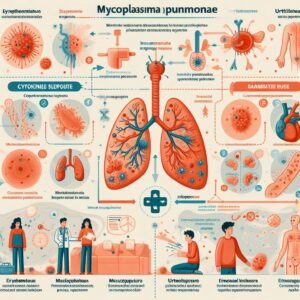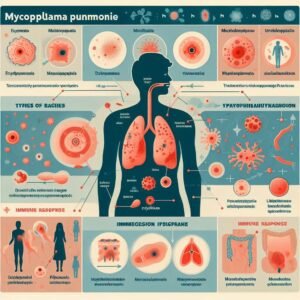Introduction
Mycoplasma pneumoniae is a fascinating bacterium that causes respiratory infections, particularly atypical pneumonia. While most people associate it primarily with respiratory symptoms, it can also lead to a variety of extraneous effects, including skin rashes. Understanding the connection between Mycoplasma pneumoniae and rash is crucial for effective diagnosis and treatment. In this article, we will explore seven surprising ways how they both can impact health.

What Is Mycoplasma pneumoniae?
Overview
It is one of the smallest known bacteria. It lacks a cell wall, which makes it unique among prokaryotes. This bacterium often infects the respiratory tract, leading to conditions ranging from mild bronchitis to severe pneumonia. Its unique structure makes it resistant to many common antibiotics, posing challenges for treatment.
The Mechanism of Infection
When these bacteria enters the respiratory system, it adheres to the epithelial cells lining the airways. This adhesion leads to cellular damage and inflammation, resulting in the classic symptoms of pneumonia, such as cough and fever. However, this infection can trigger immune responses that manifest in other areas of the body, including the skin.
The Connection Between Mycoplasma pneumoniae and Rash
Types of Rashes
Understanding the various rashes that can occur with Mycoplasma pneumoniae infection is essential. Here are some common types:
- Erythematous Rashes: These appear as red patches on the skin and can occur anywhere on the body.
- Maculopapular Rashes: These rashes consist of small raised bumps and can be itchy, often resembling allergic reactions.
- Urticaria: Also known as hives, this rash presents as raised, itchy welts that can vary in size.
- Mucosal Rashes: Sometimes, the rash may occur on mucous membranes, such as in the mouth or eyes.
How Mycoplasma pneumoniae Causes Rashes
The connection between Mycoplasma pneumoniae and rash stems from the immune response to the infection. When the body detects the presence of the bacteria, it releases various cytokines and inflammatory mediators. These substances can lead to increased blood flow and permeability in the skin, resulting in rashes. In some cases, the immune system may mistakenly attack the skin cells due to molecular mimicry, where bacterial antigens resemble those of host tissues.
Symptoms of Infection
Respiratory Symptoms
When individuals contract Mycoplasma pneumoniae, they commonly experience respiratory symptoms. These may include:
- Persistent cough
- Fever
- Sore throat
- Fatigue
- Headaches
Extraneous Symptoms: The Rash Connection
In addition to respiratory symptoms, many individuals develop skin rashes. These rashes can vary widely in appearance and severity. Recognizing the presence of a rash alongside respiratory symptoms can help healthcare providers make an accurate diagnosis.
Diagnosing
Clinical Evaluation
When evaluating a patient for Mycoplasma pneumoniae infection, healthcare providers perform a thorough clinical assessment. They look for characteristic respiratory symptoms and any associated rashes. The appearance of a rash can be a key indicator that the infection is causing systemic effects.
Laboratory Tests
To confirm a diagnosis, healthcare providers often rely on several laboratory tests:
- Serological Testing: Detecting antibodies against Mycoplasma pneumoniae can help confirm an infection.
- PCR Testing: Polymerase chain reaction (PCR) tests can identify the genetic material of Bacteria in respiratory samples.
- Chest X-rays: Imaging studies help assess lung involvement and rule out other potential causes of symptoms.
Treatment Options
Antibiotic Therapy
Since Mycoplasma pneumoniae lacks a cell wall, standard antibiotics like penicillin are ineffective. Instead, healthcare providers prescribe antibiotics such as:
- Macrolides: Drugs like azithromycin are commonly used to treat Mycoplasma pneumoniae infections.
- Tetracyclines: Doxycycline is another effective option for treating this infection.
- Fluoroquinolones: Medications like levofloxacin may be used, particularly in adults.
Managing the Rash
When rashes occur alongside Mycoplasma pneumoniae infections, treatment typically focuses on alleviating symptoms:
- Topical Treatments: Corticosteroid creams can help reduce inflammation and itching associated with rashes.
- Antihistamines: These medications can effectively manage hives or allergic reactions linked to Mycoplasma pneumoniae.
- Symptomatic Relief: Ensuring the patient stays hydrated and rested is crucial for overall recovery.

Prognosis and Future Considerations
Recovery Outlook
Most patients with Mycoplasma pneumoniae infections experience a good prognosis, especially with timely and appropriate treatment. Rashes associated with the infection often resolve as the underlying illness improves.
Ongoing Research
Current research aims to better understand the relationship between Mycoplasma pneumoniae and rash. Investigating the immune mechanisms behind these skin manifestations can lead to improved diagnostic and therapeutic strategies.
Conclusion
In summary, understanding the connection between Mycoplasma pneumoniae and rash is essential for accurate diagnosis and effective treatment. This bacterium can lead to various respiratory symptoms, but it also has surprising effects on the skin. By recognizing the signs and managing the condition effectively, healthcare providers can significantly improve patient outcomes. As research continues, we anticipate further insights into this intriguing relationship, ultimately benefiting those affected by infections.


